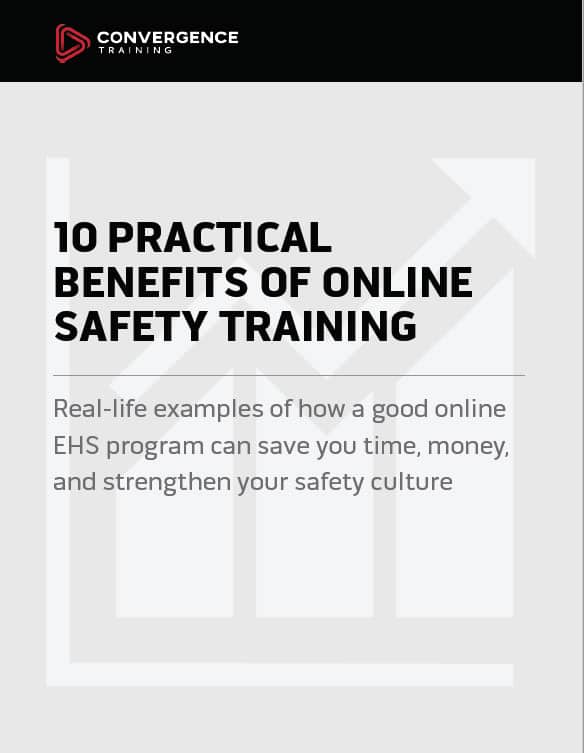February 7, 2018

9 Great Uses for Mobile Training at Work
Industry:
Solution:

Organizations are becoming increasingly interested in mobile training these days (also called mobile learning and M-learning).
Which is great, because you can use mobile training in a lot of positive ways. But on the other hand, you don't want to just rush into it, believing that this new technology is the silver bullet that will make training magical in the same way that people made the same claims about radio, TV, movies, filmstrips, video tapes, DVDs, the Internet, and more.
So in this article, we're going to list out for you some productive ways to use mobile training at work. Please add any additional ones from your experience as well.
You might also want to check out our mobile training apps or our 3 Fundamental Uses for Mobile Safety Training article.
Convergence Training are workforce training experts.
Click the links below to learn more about how we can help you.
- Learning Management Systems
- Online Workforce Training Courses
- Custom Workforce Training
- Incident Management Software
- Mobile Training Apps
9 Uses of Mobile Training at Work
Excited about mobile training but not quite sure how to best use it?
We've got nine ideas you for below that you can use today to improve your overall training program at work.
1. Self-Guided Learning on Worker's Own Schedule
One of the primary benefits of adopting mobile learning is it means workers can access, take, and complete training on their schedule, not yours.
Traditionally, workers have to attend classroom-style instruction on the date and time, and in the room, specific by the instructor. Admittedly, some organizations are better than others at scheduling instructor-led training to meet the schedule of workers, but ultimately this is still a problem.
Mobile training takes that problem off the table. With mobile training, workers have the freedom to complete the training when it works best for them.
To do this, you can use mobile training INSTEAD of instructor-led training, or you can still hold the instructor-led training session PLUS create a mobile version and let people complete either/or or even both.
2. Online Learning When Workers Don't Have Desktop Computers
In discussions of online workforce training, there's often an assumption that ever worker has a desk and a desktop computer. But those assumptions simply aren't true for many workplaces, including manufacturers, miners, transportation and other industries with remote/mobile workforces, and others.
Mobile training really shines for organizations such as these because they can "leapfrog" the requirement for expensive desktop computers and simply move straight to mobile delivery for training. With the cost of mobile devices becoming so inexpensive, the investment is quite small and pays for itself very quickly. And not only does mobile provide a less expensive way to deliver and complete online training, it also fits better into the work processes and daily flow of companies like these.
See our customer success story about customer Utility One Source to see how they utilized inexpensive Google Chromebooks to train their workforce this way.
3. Pre-Training (The "Flipped" Model of Instruction)
In many cases, classroom training can be made more productive if workers have had some exposure to the topic online before the class begins. This concept of introducing the workers to the training material first online and then in a class session is often known as the flipped model of instruction. One benefit of the flipped model is it uses the earlier online training session to disseminate knowledge so that the classroom training session can focus on demonstrations, hands-on activities, questions, and feedback--the kinds of thing that are truly beneficial during face-to-face training.
Training delivered to workers on mobile devices make it even easier and more practical to put this flipped model into use.
[optin-monster slug="zuzuvyij6mtvscihsoql"]
4. Post-Training and Spaced Practice
If the point above was about using mobile to deliver material BEFORE the primary training event, then this point is the exact opposite: using mobile to deliver training material AFTER the primary training event.
One of the instructional techniques with the most evidence supporting its effectiveness is the idea of spaced practice, also sometimes called space learning. When you're using spaced practice, you "space out" training so that the worker gets exposed to the material, and gets to practice retrieving the information and/or using the skills, at intervals over time.
The difficulty required for the worker to retrieve that information or that skill, and put it back into active thought or use, ultimately helps to defeat the human tendency to forget things that we learn in training.
For more information about this, read our articles on the forgetting curve and spaced practice.
5. Field-Based Skill Demonstrations and Evaluations
In many cases, it's helpful or necessary to provide training not in a classroom but in the field or work area. For example, this is often true of forklift training, and it can also be true when you're teaching a worker to operate new equipment or machines or to perform a new task.
Mobile devices can be very helpful in this training context. For example, you can use the mobile device to:
- Play a video that presents the proper procedure
- List the evaluation criteria so that the supervisor/observer knows how to evaluate the worker's performance
- "Check" the worker off for each step of the task he/she performs properly
- Note steps of the task the worker doesn't perform properly
- Write down comments about the worker's performance of each step in the job task
- Give credit to the worker for successfully completing the task training and skill demonstration (or withhold credit)
- Get and save the worker's digital signature
- Get and save the trainer's digital signature
- Sync all this information with your learning management system (LMS)
You can probably easily imagine how mobile training on a smart phone or tablet like the one shown below can help facilitate all this.
And by the way, did you know that research shows that training delivered in the field this way, where the workers will actually perform the job task, transfer of the training to the actual job tends to be higher?
6. On-the-Job Performance Support
Training's great, but study after study shows that a LOT of the learning that occurs in an organization happens in other, less formal manners. Often, employees learn simply by asking a coworker a question at a moment of need, or even by doing a quick Google search.
Mobile devices are great for helping employees retrieve this kind of necessary information at the point of need while on the job and performing the job task.
What's better, you can even put QR codes or bar codes on different machines and equipment in your work area and workers can use the built-in scanner in their mobile device to quickly filter and retrieve relevant information from your entire training library, as the photo below illustrates.
To take this idea one point further, ask yourself this: would you rather have an employee in the field making a decision based on something they think they remember correctly from classroom training three months ago, or would you rather have them quickly pull up the information on a mobile device seconds before they perform the job task?
8. Training for Employees Who Work Remotely
Does your organization have workers that travel or otherwise work remotely?
If so, you know it's difficult, expensive, or even sometimes impossible to deliver training to them. In terms of expense along, just think about the travel expenses organizations often incur while trying to train remote workers: flying them to a central location; putting them up at a hotel; paying for food and drinks; possibly even having to rent a training location.
Imagine how much easier and how much less expensive this can be if you're using online training support by mobile training apps and devices. And it's not an issue of saving money on training delivery. You'll also get these benefits:
- Improved worker performance as a result of completing training they might not otherwise receive (if the company decided it was too expensive to hold the training without the use of mobile devices)
- Improved compliance with regulatory training requirements
- Decreased risk exposure as a result of more and better training (compliance, injuries and illnesses, operational inefficiencies, lost sales, etc.)
[optin-monster slug="uufvrka22l7n4ppq0byf"]
9. Quick, Nearly Instant Updates to Employees
Consider this scenario. Your training program has been chugging along with perfect efficiency and success. You've dotted all your (instructional) I's, you've crossed all your (training) T's.
And then, some change occurs at work, or some lesson has been learned, and you need a way to distribute the information and inform workers quickly.
Sure, you can try to pull together a last-minute instructor-led training session or meeting, but you probably already know it won't be easy to do and that many workers will have trouble attending or simply won't be able to attend.
It will be much easier to create an online training for this kind of need and then distribute it to workers so they can access it with their mobile devices. You'll get the new, important information to more workers in less time that way.
You can even follow that up with an instructor-led session if you wish, but at least you've distributed the information as quickly and efficiently as possible with the mobile learning application.
Mobile Training Has Many Productive Uses--Consider Adding it to Your Workforce Training Program
We hope this article has given you some ideas of how you can add mobile training to your current training efforts at work.
Let us know if you've got some questions. Otherwise, feel free to download the free related guide below.

Benefits of Online Safety Training
Wondering if you should make the plunge with online safety training? This guide gives 10 reasons why, each based on experiences at real companies like yours.

Related Resources

How Food and Safety Training Courses Strengthen Your Reputation in Food & Beverage Manufacturing
March 31 2025

Customer Testimonial: Transforming Workforce Development with Vector LMS and Training
March 19 2025

Customer Testimonial: CDL Online Training
January 24 2025
Explore our software solutions designed to help your organization succeed
Request a Demo



